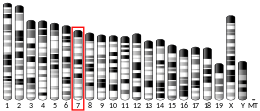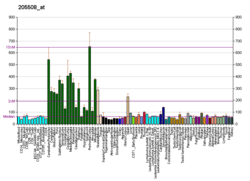SCN1B
Sodium channel subunit beta-1 is a protein that in humans is encoded by the SCN1B gene.[5][6]
Voltage-gated sodium channels are essential for the generation and propagation of action potentials in striated muscle and neuronal tissues. Biochemically, they consist of a large alpha subunit and 1 or 2 smaller beta subunits, such as SCN1B. The alpha subunit alone can exhibit all the functional attributes of a voltage-gated Na+ channel, but requires a beta-1 subunit for normal inactivation kinetics.[supplied by OMIM][6]
Clinical significance
Mutation in the SCN1B gene are associated with disorders such as Brugada syndrome and GEFS.
See also
References
- GRCh38: Ensembl release 89: ENSG00000105711 - Ensembl, May 2017
- GRCm38: Ensembl release 89: ENSMUSG00000019194 - Ensembl, May 2017
- "Human PubMed Reference:". National Center for Biotechnology Information, U.S. National Library of Medicine.
- "Mouse PubMed Reference:". National Center for Biotechnology Information, U.S. National Library of Medicine.
- McClatchey AI, Cannon SC, Slaugenhaupt SA, Gusella JF (Sep 1993). "The cloning and expression of a sodium channel beta 1-subunit cDNA from human brain". Hum Mol Genet. 2 (6): 745–9. doi:10.1093/hmg/2.6.745. PMID 8394762.
- "Entrez Gene: SCN1B sodium channel, voltage-gated, type I, beta".
Further reading
- Hartshorne RP, Catterall WA (1984). "The sodium channel from rat brain. Purification and subunit composition". J. Biol. Chem. 259 (3): 1667–75. PMID 6319405.
- Makita N, Sloan-Brown K, Weghuis DO, et al. (1995). "Genomic organization and chromosomal assignment of the human voltage-gated Na+ channel beta 1 subunit gene (SCN1B)". Genomics. 23 (3): 628–34. doi:10.1006/geno.1994.1551. PMID 7851891.
- Makita N, Bennett PB, George AL (1994). "Voltage-gated Na+ channel beta 1 subunit mRNA expressed in adult human skeletal muscle, heart, and brain is encoded by a single gene". J. Biol. Chem. 269 (10): 7571–8. PMID 8125980.
- Wallace RH, Wang DW, Singh R, et al. (1998). "Febrile seizures and generalized epilepsy associated with a mutation in the Na+-channel beta1 subunit gene SCN1B". Nat. Genet. 19 (4): 366–70. doi:10.1038/1252. PMID 9697698.
- Ratcliffe CF, Westenbroek RE, Curtis R, Catterall WA (2001). "Sodium channel beta1 and beta3 subunits associate with neurofascin through their extracellular immunoglobulin-like domain". J. Cell Biol. 154 (2): 427–34. doi:10.1083/jcb.200102086. PMC 2150779. PMID 11470829.
- Fahmi AI, Patel M, Stevens EB, et al. (2002). "The sodium channel beta-subunit SCN3b modulates the kinetics of SCN5a and is expressed heterogeneously in sheep heart". J. Physiol. 537 (Pt 3): 693–700. doi:10.1113/jphysiol.2001.012691. PMC 2278985. PMID 11744748.
- Malhotra JD, Koopmann MC, Kazen-Gillespie KA, et al. (2002). "Structural requirements for interaction of sodium channel beta 1 subunits with ankyrin". J. Biol. Chem. 277 (29): 26681–8. doi:10.1074/jbc.M202354200. PMID 11997395.
- Wallace RH, Scheffer IE, Parasivam G, et al. (2002). "Generalized epilepsy with febrile seizures plus: mutation of the sodium channel subunit SCN1B". Neurology. 58 (9): 1426–9. doi:10.1212/wnl.58.9.1426. PMID 12011299.
- Strausberg RL, Feingold EA, Grouse LH, et al. (2003). "Generation and initial analysis of more than 15,000 full-length human and mouse cDNA sequences". Proc. Natl. Acad. Sci. U.S.A. 99 (26): 16899–903. doi:10.1073/pnas.242603899. PMC 139241. PMID 12477932.
- Meadows LS, Malhotra J, Loukas A, et al. (2003). "Functional and biochemical analysis of a sodium channel beta1 subunit mutation responsible for generalized epilepsy with febrile seizures plus type 1". J. Neurosci. 22 (24): 10699–709. doi:10.1523/JNEUROSCI.22-24-10699.2002. PMC 6758463. PMID 12486163.
- Aronica E, Troost D, Rozemuller AJ, et al. (2003). "Expression and regulation of voltage-gated sodium channel beta1 subunit protein in human gliosis-associated pathologies". Acta Neuropathol. 105 (5): 515–23. doi:10.1007/s00401-003-0677-2. hdl:2027.42/42208. PMID 12677453.
- Audenaert D, Claes L, Ceulemans B, et al. (2004). "A deletion in SCN1B is associated with febrile seizures and early-onset absence epilepsy". Neurology. 61 (6): 854–6. doi:10.1212/01.wnl.0000080362.55784.1c. PMID 14504340.
- Qin N, D'Andrea MR, Lubin ML, et al. (2004). "Molecular cloning and functional expression of the human sodium channel beta1B subunit, a novel splicing variant of the beta1 subunit". Eur. J. Biochem. 270 (23): 4762–70. doi:10.1046/j.1432-1033.2003.03878.x. PMID 14622265.
- McEwen DP, Meadows LS, Chen C, et al. (2004). "Sodium channel beta1 subunit-mediated modulation of Nav1.2 currents and cell surface density is dependent on interactions with contactin and ankyrin". J. Biol. Chem. 279 (16): 16044–9. doi:10.1074/jbc.M400856200. PMID 14761957.
- Gerhard DS, Wagner L, Feingold EA, et al. (2004). "The status, quality, and expansion of the NIH full-length cDNA project: the Mammalian Gene Collection (MGC)". Genome Res. 14 (10B): 2121–7. doi:10.1101/gr.2596504. PMC 528928. PMID 15489334.
- Platoshyn O, Remillard CV, Fantozzi I, et al. (2006). "Identification of functional voltage-gated Na(+) channels in cultured human pulmonary artery smooth muscle cells". Pflügers Arch. 451 (2): 380–7. doi:10.1007/s00424-005-1478-3. PMC 1351366. PMID 16052353.
- Thomas EA, Xu R, Petrou S (2007). "Computational analysis of the R85C and R85H epilepsy mutations in Na+ channel beta1 subunits". Neuroscience. 147 (4): 1034–46. doi:10.1016/j.neuroscience.2007.05.010. PMID 17604911.
- Xu R, Thomas EA, Gazina EV, et al. (2007). "Generalized epilepsy with febrile seizures plus-associated sodium channel beta1 subunit mutations severely reduce beta subunit-mediated modulation of sodium channel function". Neuroscience. 148 (1): 164–74. doi:10.1016/j.neuroscience.2007.05.038. PMID 17629415.
External links
- GeneReviews/NIH/NCBI/UW entry on Brugada syndrome
- SCN1B+protein,+human at the US National Library of Medicine Medical Subject Headings (MeSH)
This article incorporates text from the United States National Library of Medicine, which is in the public domain.
This article is issued from Wikipedia. The text is licensed under Creative Commons - Attribution - Sharealike. Additional terms may apply for the media files.




